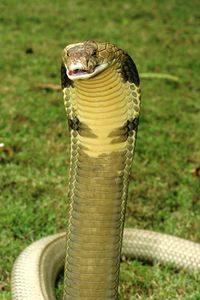King cobra: Difference between revisions
Jump to navigation
Jump to search

imported>Francis Zaia (Created page with "{{subpages}} {{Taxobox | color = pink | name = ''King cobra'' | image = Ophiophagus hannah.jpeg | image_caption = King cobra | status = vu | status_ref = <ref name=iucn>[http:/...") |
imported>Francis Zaia No edit summary |
||
| Line 51: | Line 51: | ||
}} | }} | ||
The '''King cobra''' (''Ophiophagus hannah'') is the largest [[Snake venom|venomous]] snake in the world, capable of growing up to a maximum length of {{convert|5.5|m|ft}}.<ref name=mehrtens>Mehrtens, John. (1987). ''Living Snakes of the World.'' New York: Sterling. ISBN 0-8069-6461-8.</ref> Despite the word "cobra" in its name, this snake is not a member of the ''[[Naja]]'' ("true cobras") genus. ''Ophiophagus'' is monotypic [[genus]] created for this [[Elapidae|elapid]] whose main prey is other snakes, including other venomous snakes and small pythons. This species' range spans from the forests of [[India]] through much of [[Southeast Asia]] to [[Indonesia]] and the [[Philippines]]. This is a very elusive species, rarely seen and rarely bites humans, when it does, however, the mortality rate is generally low. | |||
Revision as of 17:45, 23 May 2012
| King cobra | ||||||||||||||||||||
|---|---|---|---|---|---|---|---|---|---|---|---|---|---|---|---|---|---|---|---|---|
 King cobra
| ||||||||||||||||||||
| Conservation status | ||||||||||||||||||||
| Scientific classification | ||||||||||||||||||||
| ||||||||||||||||||||
| Binomial name | ||||||||||||||||||||
| Ophiophagus hannah (Cantor, 1836)[2][3][4] | ||||||||||||||||||||
| Synonyms | ||||||||||||||||||||
|
The King cobra (Ophiophagus hannah) is the largest venomous snake in the world, capable of growing up to a maximum length of 5.5 m (18.04 ft).[5] Despite the word "cobra" in its name, this snake is not a member of the Naja ("true cobras") genus. Ophiophagus is monotypic genus created for this elapid whose main prey is other snakes, including other venomous snakes and small pythons. This species' range spans from the forests of India through much of Southeast Asia to Indonesia and the Philippines. This is a very elusive species, rarely seen and rarely bites humans, when it does, however, the mortality rate is generally low.
Cited references
- ↑ Ophiophagus hannah at The IUCN Red List of Threatened Species. Accessed 23 May 2012.
- ↑ Ophiophagus hannah (TSN 700646) at Integrated Taxonomic Information System. Accessed 23 May 2012.
- ↑ Ophiophagus hannah (CANTOR, 1836) at The Reptile Database. Accessed 23 May 2012.
- ↑ Ophiophagus hannah at National Center for Biotechnology Information. Accessed 23 May 2012.
- ↑ Mehrtens, John. (1987). Living Snakes of the World. New York: Sterling. ISBN 0-8069-6461-8.
